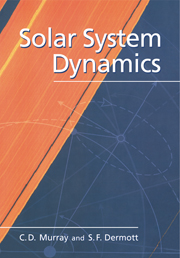Book contents
- Frontmatter
- Contents
- Preface
- 1 Structure of the Solar System
- 2 The Two-Body Problem
- 3 The Restricted Three-Body Problem
- 4 Tides, Rotation, and Shape
- 5 Spin–Orbit Coupling
- 6 The Disturbing Function
- 7 Secular Perturbations
- 8 Resonant Perturbations
- 9 Chaos and Long-Term Evolution
- 10 Planetary Rings
- Appendix A Solar System Data
- Appendix B Expansion of the Disturbing Function
- References
- Index
Preface
Published online by Cambridge University Press: 05 June 2012
- Frontmatter
- Contents
- Preface
- 1 Structure of the Solar System
- 2 The Two-Body Problem
- 3 The Restricted Three-Body Problem
- 4 Tides, Rotation, and Shape
- 5 Spin–Orbit Coupling
- 6 The Disturbing Function
- 7 Secular Perturbations
- 8 Resonant Perturbations
- 9 Chaos and Long-Term Evolution
- 10 Planetary Rings
- Appendix A Solar System Data
- Appendix B Expansion of the Disturbing Function
- References
- Index
Summary
What is a Man,
If his chief good and market of his time
Be but to sleep and feed? A beast, no more.
Sure, he that made us with such large discourse,
Looking before and after, gave us not
That capability and god-like reason
To fust in us unused.
William Shakespeare, Hamlet, IV, ivWe are living in a new age of discovery. The major voyages of exploration in the fifteenth and sixteenth centuries have modern parallels in the interplanetary spacecraft missions that have “discovered” our solar system. The data from these spacecraft combined with ground-based observations have revealed a solar system that is more than a collection of planets, satellites, asteroids, comets, and dust distributed in some arbitrary fashion: It has an intricate dynamical structure, which can be largely understood by the application of a simple inverse square law of force to its constituent bodies. To understand the dynamical structure and evolution of the solar system we must therefore understand the qualitative and quantitative effects of the universal law of gravitation.
We consider solar system dynamics to be the application of the techniques of celestial mechanics to solve real problems in planetary science. There are several classical texts on celestial mechanics and many are still in use today. These include the books by Plummer (1918), Brown & Shook (1933), Brouwer & Clemence, (1961) and, more recently Danby (1988). The books by Hagihara (1970, 1972a,b, 1974a,b, 1975a,b, 1976a,b) are authoritative works of reference but make little attempt to convey understanding.
- Type
- Chapter
- Information
- Solar System Dynamics , pp. xi - xivPublisher: Cambridge University PressPrint publication year: 2000
- 1
- Cited by

